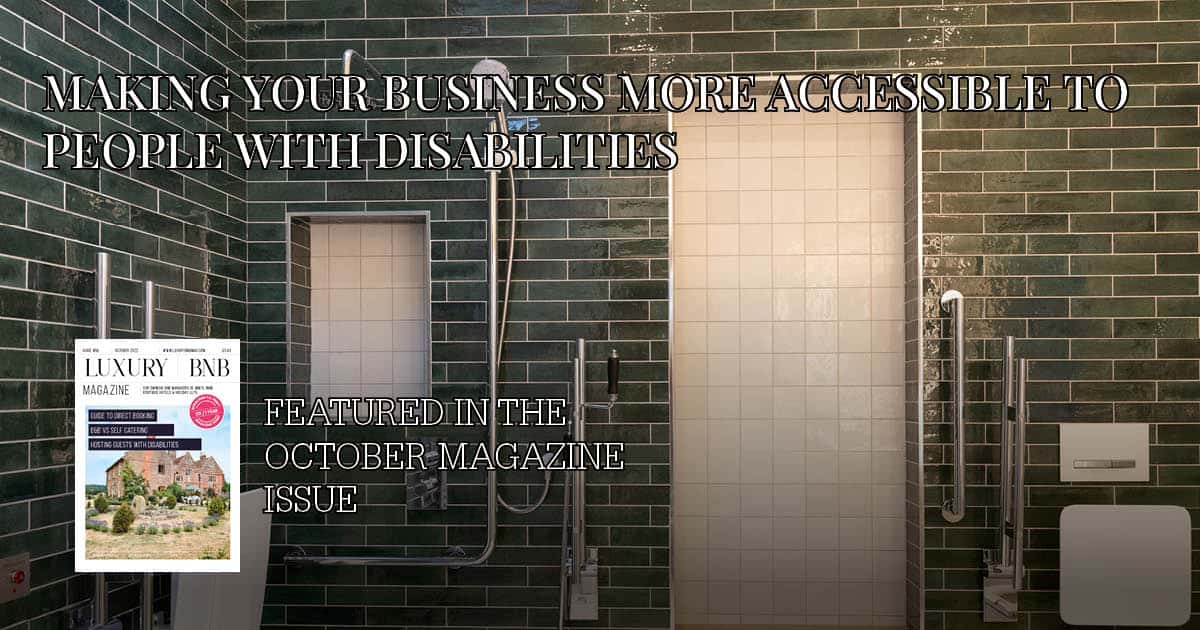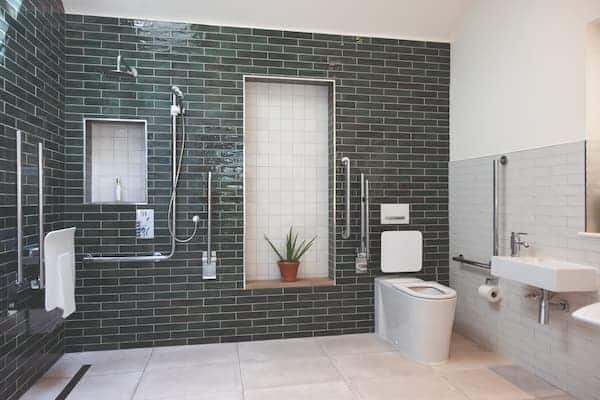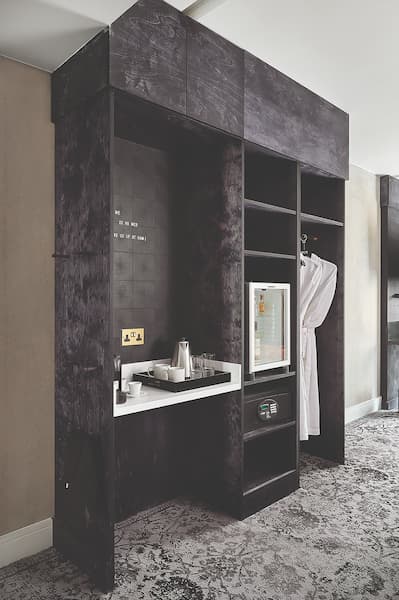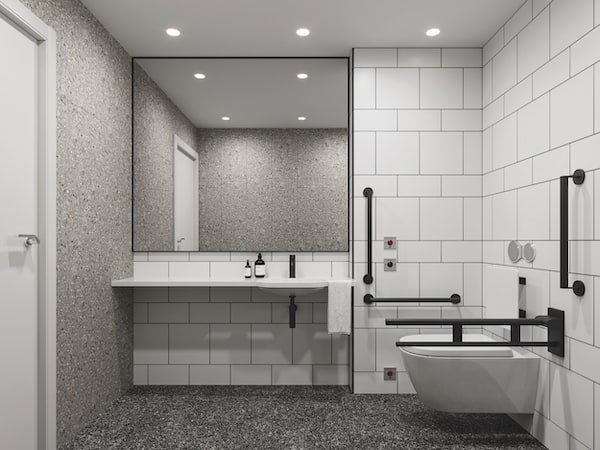
Inclusivity and accessibility are important factors to consider when you own a hospitality business. We catch up with industry experts to find out what steps you can take to make your accommodation accessible to the disabled.
According to Scope, the charity advocating for equality for the disabled, there are an estimated 14.6 million disabled people in the UK.
So how do you make sure that the members of this community are provided for when they come to stay with you?
Here we speak to two specialist companies founded with the aim of developing technology and furniture facilities to assist the disabled on holiday, in order to find out how you can improve your accommodation for guests with disabilities.
Srin Madipalli is former CEO and co-founder of Accomable, a travel tech platform for booking accessible holiday rentals acquired by Airbnb in 2017.
Alison Hughes is interiors director at Coast Road Furniture, which sells products to help specifically with mobility.
What is the most important aspect of accommodating guests with disabilities?
Srin: It is crucial to be upfront in your listing, making clear the level of accessibility and whether it is only accessible for particular requirements. There may be steps at your property, for example. Providing this detail will enable whoever is booking to decide whether or not it works for them.
What does a business owner need to do if they want their business to become more accessible?
Alison: Firstly, if you’re unsure of where to start, I’d recommend arranging a Disability Access Audit of your property. This may add to your budget slightly, but these detailed reports are a worthwhile investment as they determine what accessibility adjustments you can and cannot achieve. They can also help you avoid costly mistakes, such as embarking on modifications that simply aren’t feasible.
It’s also important for owners to be honest about what their property can offer. If accessibility improvements are still in progress, be clear and upfront about your bedrooms, parking or bathrooms and any provisions you can make during their stay. Potential customers must know about potential issues before their visit, so they can prepare accordingly or plan to stay with you once your property has been updated. This means their experience at your accommodation will be much better, thus leaving you less vulnerable to negative reviews.
Srin: The first thing to do is seek professional advice as to what can be modified. For instance, what adjustments can be made to the building? Can doors be expanded? Can bathrooms be made accessible?
You also need to work on the photos and copy for your listing, to ensure everything is as accurate as possible. Always use high quality photos and, if in doubt, be really descriptive and honest so people can decide what works for them.
You must manage people’s expectations. What an elderly person needs may be different to what a blind person requires, which in turn will be different from what a wheelchair user needs. It is a challenge to have everything ready to accommodate every disability from the get-go, so you must consider what is realistic in terms of modifications. Even if you can’t do anything structurally to your building, simply being upfront about what is available and possible will greatly help your guests.
Where should owners go for professional advice?
Srin: There are plenty of agencies and companies that will provide consultations and plenty of specialist agencies that make accessible bathrooms and other such features. These can easily be found using Google. Property owners can check out the National Accessibility Scheme, while VisitEngland offers an accessibility guide. You can also contact charities. There are many organisations that employ people who are disabled and who are therefore very good at advising on such matters.
What kind of features can owners put in place to become more accessible?
Srin: At the most basic level, if you only have a couple of steps at your entrance, there is no need for you to seek out a specialist store, because ramps are available to buy online from Amazon. But before you dive straight into modifying your building, you need to understand that accessibility covers a wide spectrum. Everyone has different needs, so you must be realistic about what you can offer within the limitations of your budget and your property.
There are various things that do not require costly renovation, such as installing ramps, roll-in showers, braille signage and hearing loops. As a property owner you just need to do your homework so you know what exactly is possible for your business.
Alison: I’d suggest it’s best to start with the basics, such as providing wheelchair ramps and a disabled bathroom. These are the main obstacles faced by customers with limited mobility and are therefore the most important things to start resolving.
It’s important to remember that, while wheelchair access is a key part of physical accessibility, less than 8% of disabled people are wheelchair-users (source: Enhance the UK). There are a multitude of other disabilities that the hospitality industry could cater to more effectively and in so doing can make a huge difference to your guests’ stay – and therefore of course their chance of returning. For example, a seemingly small yet much-appreciated addition could be to provide a remote control with audio descriptions and subtitles for customers who are deaf or visually impaired. You may also provide menus with larger print to help the partially sighted order their food more easily and thus maintain their independence.
How can bathrooms and toilets be made more accessible?
Alison: As well as ensuring that the room itself is large enough for a wheelchair or scooter user to roll into, disabled bathrooms should always be fitted with handrails and a slightly higher toilet to help with wheelchair transfers.
Handrails are a great addition, as they are inexpensive yet can make a huge difference to usability and prevent accidents. In the UK, it’s required that five supporting rails are provided in every accessible bathroom, painted in a contrasting colour to aid visually impaired guests. [One such provider is Liverpool-based Total Cubicles.] Along with roll-in showers, disabled bathrooms must also be fitted with an emergency assistance alarm and an outward-opening access door.
What is the range of options, from the cheapest to the more expensive?
Alison: While ramps, lifts, and other large-scale modifications may be a sizeable financial investment for your property, there are plenty of more affordable additions you can make to improve overall accessibility in your B&B or holiday let. For example, bedside fire alarm monitors for those who are deaf or hearing-impaired don’t require any professional installation. They simply need regular battery charging.
Smaller additions such as larger-print menus can easily be made on-site using the recommended size 16 or 14 font and confirming numbers that are often misread — like 3,5,8, and 0 — with words wherever possible (source: Macular Society).
What advice would you give to owners in general about making their business more accessible?
Srin: You need to be realistic. It is one of those things that cannot be undertaken without due care and intent, otherwise you could just end up doing more harm to your property and your business than good.
You are better off being honest and simply telling people who enquire that your property isn’t accessible, so they don’t waste their time booking something that’s not practical.
You will want your property to be accessible but also to look beautiful. There is an agency called Motionspot that specialises in pleasant-looking, accessible spaces. They’ve won awards for their beautiful designs and we have referred many people to them. They create amazing accessible designs that have neither the look nor the feel of a hospital. People often forget about aesthetics and design when thinking about accessibility, but it is possible to do both.
Alison: When the time comes to update the décor of your property or repair broken furnishings, take this opportunity to improve your accessibility credentials one step at a time.
For instance, when choosing new bathroom fittings, try opting for taps with sensors or longer levers. These might be a little more expensive than some of the basic models, but they are a worthwhile investment that can make it much easier for guests with limited mobility to use your sinks. Furthermore, sensor taps can help you to save money on water and energy bills.
In terms of layout, you may be able to incorporate lower light switches into your bedrooms when redecorating or rewiring. These won’t inconvenience other customers, yet they can make a big difference for wheelchair users visiting your establishment. Installing lowered countertops or adjustable desks into your wheelchair-friendly rooms is also a great – and surprisingly affordable – way to make them more accessible.
The following organisations can provide expertise and online advice:
- Coast Road Furniture
- Scope
- Tourism for All
- VisitEngland
- Enhance the UK
- Total Cubicles
- Macular Society
- Motion Spot
- Checkatrade
Light-touch changes to make your holiday property more accessible
- Make the location of the property and parking clear by using a large, sans-serif font that contrasts well against its background and is viewable from a distance. Symbols on signage should be universally recognisable.
- Contrast helps to define a space and the features within it and is particularly useful for people with visual or cognitive impairments. Helpful changes include painting walls a contrasting colour to the floor and ceiling, and painting the frame of the door in a contrasting colour. Taking a picture of a space and adding a black and white filter offers a quick and easy way to see how much contrast there appears to be between surfaces.
- Position items so that they can be reached by people from a seated or standing position. For example, drop down baskets can assist with reach heights, sockets and switches should be easy to operate for people with limited dexterity, i.e. a push pad rather than requiring pinching, twisting or grasping.
- Include a range of furniture options because lower furniture may be difficult for people to rise from or lower onto, for example older people and those with motor conditions. Some people need armrests to lower and rise from seating, while others prefer chairs without armrests, so both options should be offered. Cushioned furniture should be soft but provide firm enough support so that it doesn’t ‘sink’ when sat on and become difficult to rise from.
- In the bathroom, wherever possible, create a level, open entry into shower cubicles as this helps prevent obstructions. If space allows, provide a folding shower chair for people who prefer or need to sit whilst washing. Provide details that will support people who are less steady on their feet, such as grab rails in the shower and slip resistant matting inside and outside the shower or bathtub. Lever style taps, operable with a closed fist or elbow are easier for everyone to use, and water temperature and pressure indicators should be clearly marked e.g. with ‘H’ and ‘C’ and blue and red colours.
- In bedrooms, a profiling bed can support a range of visitors by providing a backrest and knee profile if needed. Ensure circulation space is available around the bed to accommodate mobility equipment and carers. Provide lower height shelving and/or adjustable height clothing rails.
- When it comes to lighting, provide an even distribution of lighting in the kitchen, bathroom, and any space where accuracy is required. Task lighting under kitchen cupboards highlights the work surface and is helpful for everyone. Adjustable lighting controls accommodate a range of needs and preferences, for instance people who experience sensory overload or migraines. Where this is not possible, a variety of lamps and low-level lighting options may be offered, and note that large push-plate light switches are easier to locate and operate.
- Embrace technology. For example, digital, vibrating pillow alarms that alert guests who are deaf or hard of hearing in the event of a fire. Alexa operated controls for blinds, lighting, music etc. can assist people with limited dexterity or mobility impairments. A smart coffee maker with WIFI and voice activation which has a pot waiting for you when you wake up is a nice touch. And digital apps and shower controls which enable individuals to control the temperature of water before entering deliver great comfort.
Renovating your property into an accessible holiday home
- For full accessibility, there should be step-free access into and around the property. On approach, avoid gravel, which can be difficult to traverse with a wheelchair and for people with chronic pain or motor conditions to walk on. A canopy will provide shelter at the entrance for a person waiting for assistance or stopping to find their keys etc. A wide door will offer generous clearance for people using wheelchairs or mobility walkers to enter the property.
- For internal circulation, thresholds should be kept to a minimum. Even the smallest difference in height through a doorway can cause someone to catch their foot. Continuous, smooth surfaces should be achieved throughout the property. Avoid deep pile carpeting, which is difficult for a wheelchair to roll over. Easily moveable rugs can also cause trips and falls, so if used ensure they have chamfered edges and are fixed securely to the floor.
- Wide internal doors and circulation should include enough space to facilitate circulation into and between rooms.
- An accessible wet room should include flooring that is slip resistant and a 1,500mm turning circle should enable wheelchair access to facilities. Provide support around the toilet and in the shower by including grab rails. Some grab rails can be disguised as other features such as a shower riser or an integrated toilet roll holder. A higher positioned toilet is easier for people to sit down and rise from.
- Provide a bedroom on the ground floor, ideally with an accessible wet room leading from the bedroom. Consider whether the room will accommodate a ceiling track hoist that is compatible with different sling types. An ‘X-Y’ or ‘H’ system covers the whole room so that a person can transfer between their wheelchair and the features they need to use e.g. bed, shower, WC. A mobile hoist is an alternative option but requires storage and space for its legs under the bed.
- In the kitchen, included a lower sink and surface counter height with knee-space beneath. Controls for any appliances should be reachable from sitting and standing positions. Cupboards with glazed windows allow people to easily identify location of essential items.
Tips for making your accommodation more accessible
Thanks to Kirstie Logan, Brickhouse Cottages – www.brickhousecottages.co.uk
Listen to what your customers want and be ready to adapt. Everyone is different and has different needs.
Where possible talk directly to the person with a disability to understand first-hand what they need. Do not worry unduly about offending or upsetting them, but do be mindful of doing so wherever possible.
Study government & building regulations and consider them as the basic minimum. Wherever possible, go beyond these levels. Make your doors and indoor spaces larger than the guidelines wherever you can.
Wear your guests shoes: test your property yourself by borrowing a wheelchair or wearing a blindfold. Invite guests or your friends with a disability to test your property.
The provision of suitable access for people with disabilities can be commercially advantageous as there is still a shortage of suitable properties. You could have a group of 10 people where only one of the guests uses a wheelchair. The chance of repeat bookings if you get it right are high, as guests know what to expect. Brickhouse for instance runs at 60% to 70% repeat bookings. This year’s occupancy rate is 94%, with 60% of 2023 booked already.
Do not try to make the accessibility features look too clinical. People with disabilities are aware that they may require extra adaptions but don’t want this to be the main focal point of their break away and neither do their families or carers.
Be mindful that not all disabilities are visible therefore simple awareness and patience may be the simplest ways to make your business more inclusive.
Contacts:
Srin Madipalli
https://www.linkedin.com/in/srinmadipalli?originalSubdomain=uk
Alison Hughes
https://twitter.com/CoastRoadFurni
https://www.facebook.com/coastroadfurniture
https://www.instagram.com/coastroadfurniture/
Motion Spot
https://www.instagram.com/motionspot/
https://www.facebook.com/motionspot
https://www.linkedin.com/company/motionspot/
Brickhouse:
https://facebook.com/BrickHCottages








